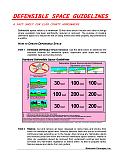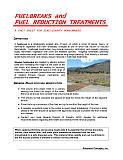Appendix E - Homeowner Guidelines
Defensible Space Guidelines
Download the Defensible Space Guidelines fact sheet for Clark County

(PDF, 187kb, 2 pages)
Homeowner’s Annual Checklist
Download the Homeowner’s Annual Checklist fact sheet for Clark County

(PDF, 55kb, 1 page)
Fuelbreaks and Fuel Reduction Treatments
Download the Fuelbreaks and Fuel Reduction Treatments fact sheet for Clark County

(PDF, 95kb, 2 pages)
Seed Mix and Planting Specifications for Elko County
| Common Name | Scientific Name | Seeding Rate PLS pounds/acre | |
|---|---|---|---|
| Drill Application | Broadcast Application | ||
| “Hycrest” wheatgrass | Agropyron fragile spp. sibericum | 8.0 | 4.0 |
| “Anatone” Bluebunch wheatgrass | Agropyron spicatum | 4.0 | 2.0 |
| “Immigrant” Forage Kochia | Kochia prostrata | 2.0** | |
| Sandberg bluegrass | Poa sandbergii | 1.5 | .75 |
| TOTAL PLS POUNDS PER ACRE | 15.5 | 8.75 | |
| **Kochia prostrata should always be broadcast seeded on the soil surface in all cases. | |||
This seed mixture is for treating all disturbed areas and areas cleared for fuel reduction purposes. Seeding application rates are specified on a “pure live seed” (PLS) basis. All seeds should be thoroughly mixed and seeded together at the same time. Drill seeding is recommended where feasible. Drill rows should be spaced as 12 inches apart and seed should be planted at a depth of 1/2 inch. Broadcast seeding is recommended for rocky, steep, or small treatment areas. The seed can be broadcast using hand held seeders such as a “Whirlybird” or a broadcast seeder mounted on an ATV. Continually mix the seed while seeding to equally distribute the small seeds throughout the mix. Following the broadcast seed application, seeded areas should be lightly raked to assure seed placement at an average depth of 1/2 inch. This can be done with hand held rakes, or by pulling a harrow implement or piece of chain link fence behind a truck or ATV in areas that are less rocky.
Use of a pre-emergent herbicide prior to seeding may be advisable in areas where cheatgrass is an apparent problem.
These guidelines are provided as overall recommendations. However, site-specific evaluation of the treatment areas by a specialist from a land management agency, the Natural Resources Conservation Service, or the University of Nevada Cooperative Extension will provide even greater assurance for success.
